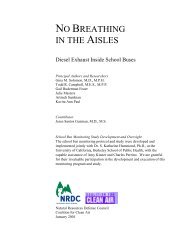US Nuclear Weapons in Europe - Natural Resources Defense Council
US Nuclear Weapons in Europe - Natural Resources Defense Council
US Nuclear Weapons in Europe - Natural Resources Defense Council
Create successful ePaper yourself
Turn your PDF publications into a flip-book with our unique Google optimized e-Paper software.
U.S. <strong>Nuclear</strong> <strong>Weapons</strong> <strong>in</strong> <strong>Europe</strong> • Hans M. Kristensen/<strong>Natural</strong> <strong>Resources</strong> <strong>Defense</strong> <strong>Council</strong>, 2005<br />
suggest<strong>in</strong>g that NATO review its nuclear policy and specifically the first-use option,<br />
which has characterized NATO doctr<strong>in</strong>e for decades. Their proposal collided with the<br />
adjustments of U.S. and NATO nuclear strategy undertaken <strong>in</strong> the 1990s to use nuclear<br />
weapons to deter not only nuclear but other types of weapons of mass destruction as<br />
well. 164 Without the option to use nuclear weapons first, some feared, NATO would<br />
rel<strong>in</strong>quish its ability to deter attacks by chemical and biological weapons. The rejection<br />
of the proposal was swift, and U.S. <strong>Defense</strong> Secretary William Cohen stated:<br />
"We th<strong>in</strong>k that the ambiguity <strong>in</strong>volved <strong>in</strong> the issue of the use of nuclear<br />
weapons contributes to our own security, keep<strong>in</strong>g any potential adversary<br />
who might use either chemical or biologicals [sic] unsure of what our<br />
response should be. So we th<strong>in</strong>k it's a sound doctr<strong>in</strong>e. It was adopted<br />
certa<strong>in</strong>ly dur<strong>in</strong>g the Cold War, but modified even follow<strong>in</strong>g and<br />
reaffirmed follow<strong>in</strong>g [sic] at the end of the Cold War. It is an <strong>in</strong>tegral part<br />
of our strategic concept, and we th<strong>in</strong>k it should rema<strong>in</strong> exactly as it is." 165<br />
On the one hand, the revolt suggested that the challenges fac<strong>in</strong>g the alliance almost 10<br />
years after the end of the Cold War were not only external but that major NATO allies<br />
were beg<strong>in</strong>n<strong>in</strong>g to th<strong>in</strong>k anew about the role of nuclear weapons. On the other hand, the<br />
revolt provided an opportunity for the nuclear weapon states to reaffirm the status quo.<br />
Eventually, Canada and Germany were persuaded to keep their differences of op<strong>in</strong>ion<br />
about nuclear doctr<strong>in</strong>e private and to discuss them <strong>in</strong>ternally with<strong>in</strong> the alliance. After<br />
all, this was a time when NATO was about to present a new Strategic Concept to expla<strong>in</strong><br />
to the world why it was still relevant <strong>in</strong> the twenty-first century.<br />
The new Strategic Concept was formally approved at the NATO Summit <strong>in</strong> Wash<strong>in</strong>gton,<br />
D.C., <strong>in</strong> April 1999. From the perspective of reduc<strong>in</strong>g or elim<strong>in</strong>at<strong>in</strong>g reliance on nuclear<br />
weapons, the Strategic Concept was a disappo<strong>in</strong>tment because it failed to change or scale<br />
back the forward deployment of U.S. nuclear weapons <strong>in</strong> <strong>Europe</strong>. Instead, it essentially<br />
ma<strong>in</strong>ta<strong>in</strong>ed the nuclear status quo repeat<strong>in</strong>g past accomplishments and reaffirmed a<br />
cont<strong>in</strong>u<strong>in</strong>g role <strong>in</strong> <strong>Europe</strong> for U.S. non-strategic nuclear weapons and British warheads<br />
on strategic submar<strong>in</strong>es. 166<br />
The failure to adjust nuclear policy was twofold <strong>in</strong> that the Strategic Concept also failed<br />
to elim<strong>in</strong>ate a nuclear role for non-nuclear NATO countries at a time when <strong>Europe</strong>an and<br />
U.S. nonproliferation efforts forcefully urged other non-nuclear countries to refra<strong>in</strong> from<br />
develop<strong>in</strong>g nuclear weapons capabilities. Instead the Strategic Concept highlighted the<br />
<strong>in</strong>volvement of non-nuclear NATO states <strong>in</strong> nuclear weapons storage and strike plann<strong>in</strong>g:<br />
“A credible alliance nuclear posture and the demonstration of alliance solidarity<br />
and common commitment to war prevention cont<strong>in</strong>ue to require widespread<br />
participation by <strong>Europe</strong>an allies <strong>in</strong>volved <strong>in</strong> collective defence plann<strong>in</strong>g <strong>in</strong> nuclear<br />
roles, <strong>in</strong> peacetime bas<strong>in</strong>g of nuclear forces on their territory, and <strong>in</strong> command,<br />
control, and consultation arrangements. <strong>Nuclear</strong> forces based <strong>in</strong> <strong>Europe</strong> and<br />
committed to NATO provide an essential political and military l<strong>in</strong>k between the<br />
<strong>Europe</strong>an and the North American members of the alliance. The alliance will<br />
54
















